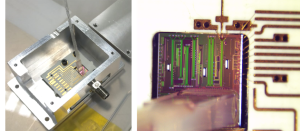At the Mobile World Congress in Barcelona, the first high-frequency radio system prototype based on photonics was presented
The future of radio systems runs through Pisa, where the National Inter-University Consortium for Telecommunications (CNIT) and the Scuola Superiore Sant’Anna are collaborating with Ericsson Research center in Pisa to develop electro-optical on-chip systems for radio communications. These chips replace fully electronic circuits to enable the use of new frequency windows, ensuring increasingly pervasive, broadband connections with low power consumption.
A team of researchers at the Photonic Networks and Technologies Laboratory of CNIT led by Dr. Antonio Malacarne e Alberto Montanaro, in collaboration with a team of the TeCIP Institute of Sant’anna School coordianted by Prof. Antonella Bogoni, and in close synergy with Ericsson—a leading company in the telecommunications sector—has developed the first on-chip prototype of an optical radio frequency carrier synthesizer and optical mixer, both operating beyond 100 GHz.
The innovative miniaturized electro-optical system, built on two silicon chips—one of which is coated with an ultra-thin graphene sheet—enabled the implementation of a radio transmission system with a 100 GHz carrier, capable of carrying more than 20 times the data of existing systems by exploiting new spectral regions that were previously unavailable.
This cutting-edge prototype, a standout on the international stage, was presented last March by Ericsson at the Mobile World Congress, the world’s largest and most influential connectivity event, held annually in Barcelona and attracting thousands of exhibitors, including operators, vendors, and manufacturers, and over 100,000 participants.
An example of “made in Italy” excellence made possible through the collaboration between academia, research, and industry.

